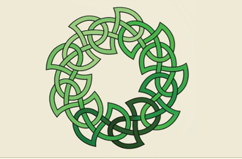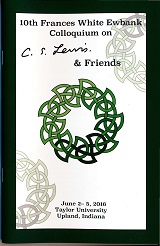Event Title
Paper Session 6-C: Sayers, Lewis, Chesterton, and the Ties that Bind
Location
Euler 118
Start Date
4-6-2016 10:45 AM
Description
"Well Met: Ties of Common Sense and Humor in the Friendship of G. K. Chesterton and Dorothy L. Sayers" - Barbara M. Prescott
The far-reaching circle of influence that surrounded C.S. Lewis included both Dorothy L. Sayers and G.K. Chesterton. Chesterton and Sayers, throughout the course of their careers, influenced one another's writings and thinking. In this paper, I explore the roots of the philosophical friendship, similar language styles, and instances in which Chesterton and Sayers influenced one another's writing careers as well as the ways in which this relationship radiated from, and at times diverged from, that of Lewis. Sayers became acquainted with the work of Chesterton from an early age (1909) by his publication of Orthodoxy. While at Oxford, Sayers attended Chesterton's lectures, as they exchanged ideas and conversed often. Their mutual appreciation of humor, poetry, and common sense in writing served to forge a long-term relationship past Oxford as Sayers began her publishing career in poetry and later in playwriting. Through study at the Marion Wade Center in Wheaton of the early poetry and writings of Dorothy L. Sayers, I have researched her letters and notebooks during Sayers' Oxford years, finding repeated references to Chesterton from 1912-1920 and am happy to share the results, to date, of this on-going research.
"Letter correspondence between C. S. Lewis and Dorothy L. Sayers" - Marsha Daigle-Williamson
Among the many friendships and literary acquaintances C. S. Lewis had, his relationship with Dorothy L. Sayers cannot be overlooked. After her first letter to Lewis in 1942, expressing her admiration for The Screwtape Letters and inviting him to write a volume for her Bridgewater series, there would follow dozens of letters between them primarily dealing with literary issues, other authors, and each other's works. Sayers's interest in Dante, kindled by her reading of Charles Williams's The Figure of Beatrice (1943), led her to translate The Divine Comedy and write two books on that poem. From that point on, one of the main topics of their letters concerned Dante, Lewis's favorite poet. What began as literary discussions between professional writers moved to friendship and personal sharing and by 1954 Lewis's letters address her as "Dorothy" rather as "Miss Sayers."
"C. S. Lewis: Mere Christian, Evangelist, Author, and Friend" - Mark R. Hall
The influence of C. S. Lewis on Christianity in the twentieth and twenty-first centuries cannot be overestimated. Because of his gregarious personality and his prolific output of writings, he influenced many in his own time. He has touched and continues to make a difference in the lives of atheists, searchers, Protestants, and Catholics alike leading them to a deeper understanding of the Christian faith, especially through his life, letters, and literature. An examination of his methodology and his overarching philosophy will lead his readers to an understanding of his pervasive and lasting legacy.
Event Type
Paper
Paper Session 6-C: Sayers, Lewis, Chesterton, and the Ties that Bind
Euler 118
"Well Met: Ties of Common Sense and Humor in the Friendship of G. K. Chesterton and Dorothy L. Sayers" - Barbara M. Prescott
The far-reaching circle of influence that surrounded C.S. Lewis included both Dorothy L. Sayers and G.K. Chesterton. Chesterton and Sayers, throughout the course of their careers, influenced one another's writings and thinking. In this paper, I explore the roots of the philosophical friendship, similar language styles, and instances in which Chesterton and Sayers influenced one another's writing careers as well as the ways in which this relationship radiated from, and at times diverged from, that of Lewis. Sayers became acquainted with the work of Chesterton from an early age (1909) by his publication of Orthodoxy. While at Oxford, Sayers attended Chesterton's lectures, as they exchanged ideas and conversed often. Their mutual appreciation of humor, poetry, and common sense in writing served to forge a long-term relationship past Oxford as Sayers began her publishing career in poetry and later in playwriting. Through study at the Marion Wade Center in Wheaton of the early poetry and writings of Dorothy L. Sayers, I have researched her letters and notebooks during Sayers' Oxford years, finding repeated references to Chesterton from 1912-1920 and am happy to share the results, to date, of this on-going research.
"Letter correspondence between C. S. Lewis and Dorothy L. Sayers" - Marsha Daigle-Williamson
Among the many friendships and literary acquaintances C. S. Lewis had, his relationship with Dorothy L. Sayers cannot be overlooked. After her first letter to Lewis in 1942, expressing her admiration for The Screwtape Letters and inviting him to write a volume for her Bridgewater series, there would follow dozens of letters between them primarily dealing with literary issues, other authors, and each other's works. Sayers's interest in Dante, kindled by her reading of Charles Williams's The Figure of Beatrice (1943), led her to translate The Divine Comedy and write two books on that poem. From that point on, one of the main topics of their letters concerned Dante, Lewis's favorite poet. What began as literary discussions between professional writers moved to friendship and personal sharing and by 1954 Lewis's letters address her as "Dorothy" rather as "Miss Sayers."
"C. S. Lewis: Mere Christian, Evangelist, Author, and Friend" - Mark R. Hall
The influence of C. S. Lewis on Christianity in the twentieth and twenty-first centuries cannot be overestimated. Because of his gregarious personality and his prolific output of writings, he influenced many in his own time. He has touched and continues to make a difference in the lives of atheists, searchers, Protestants, and Catholics alike leading them to a deeper understanding of the Christian faith, especially through his life, letters, and literature. An examination of his methodology and his overarching philosophy will lead his readers to an understanding of his pervasive and lasting legacy.


